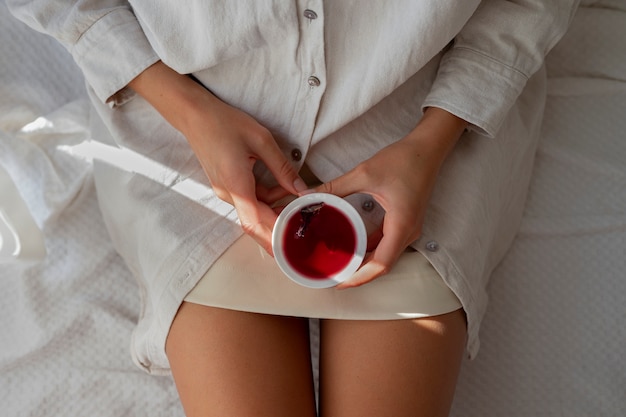
Vaginal itching is an uncomfortable sensation that causes irritation in and around the vaginal area. This tingling or heightened sensitivity, often extending to the vulva, can lead to a strong urge to scratch, bringing further discomfort.
### What Causes Vaginal Itching?
In most cases, vaginal itching or irritation is harmless. However, persistent or severe itching accompanied by burning may indicate an underlying issue that needs medical attention. Common causes include:
– **Stress:** It can weaken the immune system, making you more susceptible to infections that trigger itching.
– **Hormonal Changes:** Menopause often causes vaginal dryness due to reduced estrogen levels.
– **Allergies and Irritants:** Certain fabrics, soaps, detergents, or scented products can lead to irritation and sensitivity.
– **Yeast Infections (Yeast Vaginitis):** Candida albicans, a fungus, often causes infections, especially during pregnancy, or as a side effect of antibiotics, diabetes, birth control pills, or a weakened immune system. This condition may result in a thick white discharge along with itching.
– **Foreign Objects:** Using items like tampons without proper lubrication can cause abrasions and irritation.
– **Activities or Tight Clothing:** Wearing tight clothes or activities like horse riding and cycling can increase sensitivity and irritation.
– **Vaginitis in Children:** Young girls before puberty may develop infections. If the infection is sexually transmitted, it’s crucial to investigate and address any concerns about abuse.
– **Precancerous Skin Conditions:** Rarely, itching in the vaginal or vulvar area can signal precancerous changes.
### Symptoms Associated with Vaginal Itching
Vaginal itching is common and can sometimes be accompanied by additional symptoms like:
– Pain, redness, or swelling around the area
– Unusual vaginal discharge or bleeding
### Home Remedies for Relief and Prevention
You can take the following steps to help soothe or prevent vaginal irritation:
– **Choose Breathable Fabrics:** Opt for cotton underwear and avoid synthetic fibers, which can worsen irritation.
– **Practice Good Hygiene:** Always wear fresh, clean underwear, and avoid staying in wet or soiled undergarments that promote bacterial and yeast growth.
– **Prevent Infections:** Use condoms during intercourse to reduce the risk of sexually transmitted infections.
– **Avoid Overwashing:** Excessive washing or douching can strip the vagina of beneficial bacteria, increasing dryness and infection risk.
– **Be Cautious With Products:** Avoid scented soaps, bubble baths, or creams that can irritate sensitive skin.
– **Healthy Diet and Weight:** Eating well and maintaining a healthy weight can help resist infections.
– **Incorporate Yoghurt:** Yoghurt rich in live cultures like Lactobacillus acidophilus can support immune health and prevent infections.
– **Phytoestrogens:** Foods like tofu, flaxseed, and soy can help combat vaginal dryness.
– **Blood Sugar Management:** For diabetics, keeping blood sugar levels in check is crucial since high sugar levels can increase sensitivity.
– **Educate Young Girls:** Teach adolescent girls proper hygiene practices to avoid yeast infections.
Additional tips include:
– Avoid sexual activity until symptoms improve.
– Steer clear of activities or conditions that cause heat and sweating.
– Refrain from scratching, as it can worsen irritation.
### Natural Remedies That May Help
Some natural treatments might alleviate symptoms:
– **Lycopodium:** Believed to aid in treating redness, itching, and irritation caused by yeast infections.
– **Sepia:** A remedy that can help address vaginal dryness and itching during menopause.
– **Coconut or Olive Oil:** Useful for moisturizing and soothing irritated vaginal skin.
– **Garlic:** Known for its anti-fungal properties, consuming crushed raw garlic in drinks might help fight fungal infections.
– **Calendula Ointments:** These can rejuvenate tissue in the vaginal area.
– **Cold Compress:** A soft, cold cloth can provide immediate relief by reducing the urge to scratch.
– **Buttermilk and Apple Cider Vinegar:** These mixtures applied with a washcloth can be calming.
– **Herbal Extracts:** Ingredients like slippery elm and grapefruit seed extract might reduce discomfort.
### When to Consult a Doctor
It’s important to seek medical help if the itching includes other concerning symptoms, such as:
– Fever or lower abdominal pain
– Sudden weight loss, fatigue, or excessive thirst (possible signs of diabetes)
– Lesions or ulcers in or around the vagina
– Burning or discomfort during urination (could indicate a urinary tract infection)
– Unusual vaginal discharge, bleeding, or swelling
– Signs of sexually transmitted infections or if a sexual partner is showing symptoms
– Persistent or recurring symptoms, even with home care
### What Happens at the Doctor’s Office?
Your doctor will likely conduct a pelvic exam and ask about your symptoms to identify the cause. Depending on the situation, diagnostic tests may include a Pap smear, blood and urine tests, vaginal discharge analysis, or a skin biopsy. Based on the findings, treatment options may include:
– Hormone treatments for dryness or sensitivity
– Steroid creams to reduce itching and irritation
– Antibiotics or antifungal medications for infections, including sexually transmitted ones
Addressing vaginal itching promptly and following proper care instructions can help improve comfort and prevent further complications.